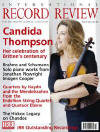Texte paru dans: / Appeared in:
*

International Record Review - (03/2013)
Pour
s'abonner / Subscription information
Hyperion
CDA67964

Code-barres / Barcode : 0034571179643
Christopher Herrick’s recordings of the complete organ works of Dietrich Buxtehude have hitherto been hugely successful. The latest release in this series is of equally high quality. Having previously played on two Scandinavian instruments — at Helsingor Cathedral in Denmark and at Nidaros Cathedral, Trondheim in Norway — Herrick returns to the region to perform at the Mariager Klosterkirke. Here is housed a fine instrument by the French builder Bernard Aubertin. This is the second time an Aubertin instrument has featured in the series; prior to this, Herrick recorded on the magnificent example at St-Louis-en-l’Île in Paris. The organ featured on this disc dates from as recently as 2010 and boasts 47 sounding stops. As is the case with all instruments by Aubertin, the Mariager Klosterkirke instrument is indebted to historic organ building practices. It is the second French built organ in the country, the other being the historic Cavaillé-Coll in the Jesus Church, Copenhagen.
Throughout the series, Herrick has selected balanced and contrasting programmes on each disc, combining the free works, including praeludia, toccatas, ostinato works and canzonas, with works based on pre-existing melodies, such as chorale or plainsong melodies. The same approach is adopted on the present recording, which consists of a number of chorale preludes, three chorale fantasias (on the Magnificat, first tone, Gelobet seist du, Jesu Christ and Ich dank dir, lieber Herre) and a set of Chorale Variations on Ach Gott und Herr, between which are interspersed six Preludes, a Fuga in G major and the Canzonetta in G major, which opens the programme.
Perhaps one of the best known of Buxtehude’s free organ works is the Praeludium in C (BuxWVI37). Herrick’s performance of this piece, successively consisting of a prelude, a fugue and ciaconne, is packed with personality and character. In the introductory notes that accompany the disc, it is remarked that ‘some of the works . . . particularly the praeludia, were intended more as models for students of improvisation . . . and so exhilarating is some of this music that one wonders how much more so Buxtehude’s “live” improvisations must have been, for notation, no matter how sophisticated, cannot by its very nature capture every note and nuance of an inspired improvisatory flight . . . ’ . While to some extent this may be true, the freedom with which Herrick approaches this piece and the extent to which it is possible to hear the performer’s voice, as well as that of the composer, projected in this performance, cannot be described as anything other than exhilarating. Herrick undoubtedly achieves the sense of spontaneity for which he is evidently striving.
We should be most grateful to the ‘A.P. Moller and wife Chastine Mc Kinney Møller’s Foundation for General Purposes’ for their donation of five million Danish kroner that enabled the organ to be built to its current specification (originally it was planned that the organ should consist of 27 stops with preparations only for another 19) . The variety of colour available to the organist is certainly much greater than would otherwise have been the case and Herrick, especially in the chorale-based repertoire, makes full use of a variety of different and interesting stop combinations. He is imaginative in the way in which he uses the sounds available to him: for example, in Nun lob, mein Seel, den Herren, the Fagott 16’ is combined with the 8’ Traversière and the 3’ Nazard and played an octave higher, creating a distinctive effect which, to the average organist, might not be an immediately obvious choice. As is the case throughout the series, details of which stops are used in each piece are recorded in the accompanying notes.
Herrick’s playing is characteristically excellent
throughout. His performances of the free works are, without exception,
rhetorically engaging and lively, while the chorale melodies sing
beautifully, such is his sensitive approach to musical line. As is the case
with the previous releases (reviewed in May 2008, February 2010 and April
and October 2011), this disc is very highly recommendable.
Fermer la fenêtre/Close window
Cliquez l'un ou l'autre
bouton pour découvrir bien d'autres critiques de CD
Click either button for many other reviews


